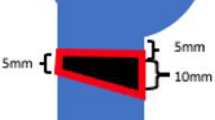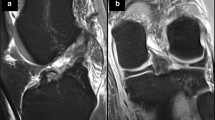Abstract
Introduction
The treatment of type III acromioclavicular injuries is controversial. Both conservative and surgical approaches have been successful. Aim of the present study was to prospectively evaluate the results of the modified Cadenat procedure in subjects with type III acromioclavicular joint injuries.
Methods
Twenty-eight patients with acute type III acromioclavicular joint dislocations (mean age 31 years) were prospectively enrolled in the present study. The delay between the injury and the surgery varied between 4 and 19 days, with an average of 8.3 days. All patients were evaluated both preoperatively and postoperatively with radiographs and clinically with visual analog scale and Constant score. A modified Cadenat procedure was performed in all cases.
Results
Twenty-five patients were evaluated at an average follow-up of 72 months. One patient had a re-dislocation 3 years after surgery. At the last follow-up, average visual analog scale score of was 0.96 (range 0–3), while mean constant score was 94.32 (range 90–99) and 92 % of patient were very happy or happy with their functional result. Radiographs showed complete reduction in 22 patients and loss of reduction in two cases. No major complications were recorded.
Interpretation
This is the first clinical report on a modified Cadenat procedure. This operation has a reduced morbidity if compared to other techniques involving autologous grafts. Moreover, it yielded good functional results, with complete pain relief, and full strength recovery at mid-term follow-up. No major loss of reduction or recurrence of instability was observed.
Level of evidence
4, Case series.





Similar content being viewed by others
References
Costic RS, Labriola JE, Rodosky MW, Debski RE (2004) Biomechanical rationale for development of anatomical reconstructions of coracoclavicular ligaments after complete acromioclavicular joint dislocations. Am J Sports Med 32(8):1929–1936
Fukuda K, Craig EV, An KN, Cofield RH, Chao EY (1986) Biomechanical study of the ligamentous system of the acromioclavicular joint. J Bone Joint Surg Am 68:434–440
Lemos MJ (1998) The evaluation and treatment of the injured acromioclavicular joint in athletes. Am J Sports Med 26(1):137–144
Rockwood CA Jr, Williams GR, Young DC (1996) Injuries to the acromioclavicular joint. In: Rockwood CA Jr, Green DP, Bucholz RW (eds) Rockwood and Green’s fractures in adults, 4th edn. Lippincott-Raven, Philadelphia, p 1341–1407
Bontempo NA, Mazzocca AD (2010) Biomechanics and treatment of acromioclavicular and sternoclavicular joint injuries. Br J Sports Med 44:361–369
Dias JJ, Gregg PJ (1991) Acromioclavicular joint injuries in sport recommendations for treatment. Sports Med 11(2):125–132
Hootman JM (2004) Acromioclavicular dislocation: conservative or surgical therapy. J Athl Train 39:10–11
Rolf O, Hann von Weyhern A, Ewers A, Boehm TD, Gohlke F (2008) Acromioclavicular dislocation Rockwood III–V: results of early versus delayed surgical treatment. Arch Orthop Trauma Surg 128:1153–1157
Bradley JP, Elkousy H (2003) Decision making: operative versus nonoperative treatment of acromioclavicular joint injuries. Clinics Sports Med 22:277–290
Gstettner C, Tauber M, Hitzl W, Resch H (2008) Rockwood type III acromioclavicular dislocation: surgical versus conservative treatment. J Shoulder Elbow Surg 17:220–225
Tauber M (2013) Management of acute acromioclavicular joint dislocations: current concepts. Arch Orthop Trauma Surg 133(7):985–995. doi:10.1007/s00402-013-1748-z
Cadenat FM (1913) Traitment des luxations et fractures externes de la clavicule. Thèse médecine. Paris n°195
Zanca P (1971) Shoulder pain: involvement of the acromioclavicular joint. Analysis of 1,000 cases. Am J Roentgenol Radium Ther Nucl Med 112:493–506
Constant CR, Murley AH (1987) A clinical method of functional assessment of the shoulder. Clin Orthop Relat Res 214:160–164
Mazzocca AD, Arciero RA, Bicos J (2007) Evaluation and treatment of acromioclavicular joint injuries. Am J Sports Med 35:316–329
Tibone J, Sellers R, Tonino P (1992) Strength testing after third-degree acromioclavicular dislocations. Am J Sports Med 20:328–331
Larsen E, Hede A (1987) Treatment of acute acromioclavicular dislocation. Three different methods of treatment prospectively studied. Acta Orthop Belg 53:480–484
Smith TO, Chester R, Pearse EO, Hing CB (2011) Operative versus non-operative management following Rockwood grade III acromioclavicular separation: a meta-analysis of the current evidence base. J Orthop Traumatol 12:19–27
Phillips AM, Smart C, Groom AF (1998) Acromioclavicular dislocation. Conservative or surgical therapy. Clin Orthop Relat Res 353:10–17
Weaver JK, Dunn HK (1972) Treatment of acromioclavicular injuries, especially complete acromioclavicular separation. J Bone Joint Surg Am 5:1187–1194
Neviaser J (1952) Acromioclavicular dislocation treated by transfer of the coracoacromial ligament. Arch Surg 64:292–297
Marcone L (1985) Contribution à l’étude du traitment chirurgical des disjontions acromio-claviculares anciennes. A propos du 23 cas traités par la méthode de Cadenat modifiée. Thèse médecine. Grenoble n°110
Saragaglia D, Julliard R, Marcone L, Butel J (1987) L’intervention de Cadenat dans le traitment des disjonctions acromio-claviculaires anciennnes at equivalents. Rev Chir Orthop 73(Supp II):187–190
Takase K, Shinmura K, Kono R, Kumakura T (2011) Therapeutic results of the modified Cadenat procedure for acromioclavicular joint separations compared with the modified Dewar procedure. West Indian Med J 60(3):303–307
Zaricznyj B (1976) Late reconstruction of the ligaments following acromioclavicular separation. J Bone Joint Surg Am 58:792–795
De Palma AF (1963) Surgical anatomy of acromioclavicular and sternoclavicular joints. Surg Clin North Am 43:1541–1550
Berson BL, Gilbert MS, Green S (1978) Acromioclavicular dislocations: treatment by transfer of the conjoined tendon and distal end of the coracoid process to the clavicle. Clin Orthop Relat Res 3:157–164
Bargren JH, Erlanger S, Dick HM (1978) Biomechanics and comparison of two operative methods of treatment of complete acromioclavicular separation. Clin Orthop Relat Res:267–272
Cox JS (1992) Current method of treatment of acromioclavicular joint dislocations. Orthopedics 15:1041–1044
Urist M (1946) Complete dislocation of the acromioclavicular joint: the nature of the traumatic lesion and effective methods of treatment with an analysis of 41 cases. J Bone Joint Surg Am 28:813–837
Jari R, Costic R, Rodosky M, Debski RE (2004) Biomechanical function of surgical procedures for acromioclavicular joint dislocation. Arthroscopy 20:237–245
Post M (1985) Current concepts in the diagnosis and management of acromioclavicular dislocations. Clin Orthop 200:234–247
Taft T, Wilson F, Oglesby J (1987) Dislocation of the acromioclavicular joint. An end-result study. J Bone Joint Surg Am 69:1045–1051
Brunelli G, Brunelli F (1988) The treatment of acromioclavicular dislocation by transfer of the short head of biceps. Int Orthop 12:105–108
Luis GE, Yong CK, Singh DA, Sengupta S, Choon DS (2007) Acromioclavicular joint dislocation: a comparative biomechanical study of the palmaris-longus tendon graft reconstruction with other augmentative methods in cadaveric models. J Orthop Surg Res 27(2):22
Liu X, Huangfu X, Zhao J (2013) Arthroscopic treatment of acute acromioclavicular joint dislocation by coracoclavicular ligament augmentation. Knee Surg Sports Traumatol Arthrosc 10. [Epub ahead of print] doi:10.1007/s00167-013-2800-9
Venjakob AJ, Salzmann GM, Gabel F, Buchmann S, Walz L, Spang JT, Vogt S, Imhoff AB (2013) Arthroscopically assisted 2-bundle anatomic reduction of acute acromioclavicular joint separations: 58-month findings. Am J Sports Med 41(3):615–621. doi:10.1177/0363546512473438
Lädermann A, Grosclaude M, Lübbeke A, Christofilopoulos P, Stern R, Rod T, Hoffmeyer P (2013) Acromioclavicular and coracoclavicular cerclage reconstruction for acute acromioclavicular joint dislocations. J Shoulder Elbow Surg 20(3):401–408. doi:10.1016/j.jse.2010.08.007
Author information
Authors and Affiliations
Corresponding author
Rights and permissions
About this article
Cite this article
Cerciello, S., Edwards, T.B., Morris, B.J. et al. The treatment of type III acromioclavicular dislocations with a modified Cadenat procedure: surgical technique and mid-term results. Arch Orthop Trauma Surg 134, 1501–1506 (2014). https://doi.org/10.1007/s00402-014-2085-6
Received:
Published:
Issue Date:
DOI: https://doi.org/10.1007/s00402-014-2085-6




